Light Environment Evaluation of the Architecturalized Immersive New Media Public Art Installation from the Audiences’ Visual Safety Perspective
Abstract
1. Introduction
2. Sample Description
3. Materials and Methods
3.1. Methods
3.2. Evaluation Indicators
3.2.1. Recommended Standards for Inner Screen Luminance
3.2.2. Recommended Standards for Inner Screen Luminance Contrast
3.3. Formula and Assessment Methods
3.3.1. Average Luminance of Inner Screens
3.3.2. Average Background Luminance of Inner Screens
3.3.3. Average Luminance Contrast
3.4. Measurement Method
3.5. Light Environment Measurement Data
3.5.1. Measurement Data of Luminance and Contrast
- Daytime luminance of inner screens
- at the entrance’s top during segments B of “Wormhole” exceeded 1000 cd/m2 (Figure 11). at the exit’s left and top of “Wormhole” also exceeded 1000 cd/m2 during segments A–C. The maximum values for and appeared at the exit top during segment B, reaching 1750 cd/m2 and 945.58 cd/m2, respectively (Figure 13), indicating that the exit of the installation was too bright. The of all parts in “Wormhole” performed well within the limitation of 1000 cd/m2 (Figure 12).
- 2.
- Daytime Luminance Contrast of Inner Screens
- The entire average luminance falls between 1:2–1:10 in the time segments E–G. is lower during segments A–D, and within segments B and C, < 1 (Figure 9), which is a negative contrast, indicating the installation was more disturbed during these two segments, resulting in less image clarity;
- The zonal average luminance meets the requirements at the entrance of the “Wormhole” during segments F and G, at the middle of the “Wormhole” during segments E and F, and at the exit of the “Wormhole” during segments A and G (Figure 10). in the middle of the “Wormhole” is relatively higher;
- The change in by time is more dramatic, with negative contrast during certain time segments and high contrast during segments F and G. There are four positions where >10, three of them are in the middle of the “Wormhole”, and one is at the entrance. The maximum value for reaches 22.44 (Figure 12).
- 3.
- Nighttime Luminance of Inner Screens
3.5.2. Subjective Evaluation of Visitors
4. Results
4.1. Analysis of Measured Data
- and are composed of artificial light + reflected light from the floor and direct natural light + reflected light from the floor, respectively. in each installation area during segment G in the evening, when natural light is weak, is only 3.96~9.98% of that during segment B in the afternoon, when light is strong. of the former is only 26.34~39.55% of the latter when the artificial light is exactly the same. This demonstrates that the contribution of natural light to the average daytime screen luminance is much greater than that of artificial light;
- Before segment E in the afternoon, the contrast of the inner screen was low due to excessive natural light entering the “Wormhole” and having a negative impact on the clarity of the screen; after segment E, the contrast increased and the image clarity improved, whereas the contrast became too high in some parts in the evening. Therefore, the Chongqing exhibition is not the best place for displaying the installation in terms of the physical “site-specific” properties;
- Compared with segment B, when daytime was the highest, the nighttime values at the entrance, the middle, and the exit of the “Wormhole” were 23.44%, 14.98%, and 14.15%, respectively. Nevertheless, these areas are quite popular among professional photographers due to nighttime images’ high contrast and sound clarity;
- The higher the outdoor temperature, the greater the temperature difference between the inside and outside of the installation. This indicates that the ventilation and heat dissipation of the installation is good and that the perforation rate of the outer skin meets the requirements of thermal engineering and heat dissipation.
4.2. Subjective Evaluation Results
4.3. On-Site Evaluation Results
- The natural light control design strategy of the installation is generally feasible. Because of the difference in the solar altitude angle and the orientation of the exhibition site, too much direct sunlight entered the device during some hours of the Chongqing exhibition, which interfered with the image and made the image presentation less clear than during the Shenzhen exhibition. However, combining the on-site experience, photo comparison, and the field data of the Chongqing exhibition, we can roughly assume that the natural light control design of “Wormhole” is basically in line with the light control requirements of the Shenzhen exhibition;
- The settings of day and night white screen luminance in the installation are generally reasonable. Low contrast in some daytime hours does not originate from the white screen luminance or the screen luminance being too low but from the background lighting consisting of natural light being too strong;
- The ventilation and heat dissipation measures of the installation are practically feasible. A 38% surface perforation rate + 30 cm heat dissipation cavity treatment was suitable for both the Shenzhen exhibition and the Chongqing exhibition, where the surface heat gain was higher (extreme weather is not under consideration here).
5. Discussion
5.1. The Necessity of High Contrast and Strong Luminance Gradient in the AINMPAI Light Environment
5.2. The Effects of Observation Position and Background Luminance on Psychophysical Quantity and Perception of True Brightness
5.3. The Effect of Positive Spatial Impressions Brought by Geometric Light Spots on Improving Glare Tolerance
5.4. Improvement Measures
- Improvement measures. If the installation is to be redesigned for the Chongqing exhibition, the form should be further adjusted to block direct sunlight more effectively and improve the luminance contrast. The perforation rate and the diameter of the holes at the top can be reduced, especially at the entrance and the exit of the “Wormhole”, to reduce the background light entering the area and enhance the clarity of the visual gaze at the center of the picture. The perforation rate in the lower part of the installation should be increased to some extent or the diameter of the holes should be increased to make up for the negative impact on heat dissipation caused by the reduced perforation rate at the top;
- Limitations in measurement methods. Since this installation was removed after the exhibition tour, the actual measurement and verification of the lighting, thermal, and acoustic environments on typical weather days throughout the year at the original site (Shenzhen) could not be carried out, which is a significant pity for this paper. In addition, due to the limited field test conditions, the intelligent control system failed to select three typical brightness pictures, namely bright, medium, and dark, to measure and calculate the internal screen light environment parameters under the static picture or to divide the brightest area under the dynamic picture state and measure the parameters [21]. Hence, the conclusions needed to be more rigorous. Given this, this paper does not provide a more in-depth description of the data obtained. It only provides a rough parameter range for designing such installations’ lighting and thermal environment;
- Shortcomings in evaluation methods. Due to the limitations of time and experimental cost, this paper only completed the physical measurement, standard comparison, and subjective evaluation of glare and comfort of the “Wormhole” light environment and we have not carried out a quantitative analysis of the relationship between the psychological, physical quantity of the observer and the appropriate luminance under different background luminance and different colors of the picture or explored its threshold range. This work needs a series of experiments and more in-depth research to support it.
6. Conclusions
7. Patents
Author Contributions
Funding
Institutional Review Board Statement
Informed Consent Statement
Data Availability Statement
Acknowledgments
Conflicts of Interest
References
- Memarovic, N.; Gehring, S.; Fischer, P.T. ELSI Model: Bridging User Engagement around Interactive Public Displays and Media Facades in Urban Spaces. J. Urban Technol. 2015, 22, 113–131. [Google Scholar] [CrossRef]
- Lee, S. A Study on the Trends for Expression in Korean Contemporary Architectural Facade Design: Focusing on Large Buildings in the City Center. Buildings 2021, 11, 274. [Google Scholar] [CrossRef]
- Moloney, J.; Globa, A.; Wang, R.; Khoo, C.K.; Tokede, O. Hybrid environmental-media facades: Rationale and feasibility. Archit. Eng. Des. Manag. 2019, 15, 313–333. [Google Scholar] [CrossRef]
- Lv, S. Interpretation of Art Text on the Dimension of Media. J. Art Commun. 2021, 4, 35–42. [Google Scholar] [CrossRef]
- Kim, J. Analysis of Preference Survey for the Media Facade Cases according to the Sensibility Keywords. Korean Inst. Inter. Des. J. 2013, 22, 58–67. [Google Scholar] [CrossRef]
- Augmented Structures. Augmented Structures V1.0/Acoustic Formations. Available online: http://augmentedstructures.com (accessed on 16 January 2023).
- Cha, M.-H. A Study on Application Examples of Media Facade by Technology Case and Content Type. J. Digit. Art Eng. Multimed. 2018, 5, 175–184. [Google Scholar] [CrossRef]
- Gawad, I.O.; Bahgat, H.; Mohamed, R.O. Sustainable potentials and Limitations of Using Media Façades in Egypt. Acad. Res. Community Publ. 2019, 3, 99–110. [Google Scholar] [CrossRef]
- Leung, I.S. Artificial Landscape: In search of publicness through urban spectacle in Hong Kong. Archit. MPS 2021, 20. [Google Scholar] [CrossRef]
- Mcarthur, I. Mapping Chongqing’s Urban Media Ecology. In Proceedings of the 4th Media Architecture Biennale Conference, Beijing, China, 13 November 2018; pp. 1–10. [Google Scholar]
- Yan, Y.; Zhong, Y.; Zhong, B. From “Art on the Shelf” to Urban Public Space: The Immersive Light Art Installation through the Wornhole. New Archit. 2021, 199, 150–153. [Google Scholar] [CrossRef]
- Xie, J. The Construction of Spectacle in Urban Images: A Case of Shanghai Images under Media Construction. Southeast Commun. 2016, 141, 83–85. [Google Scholar] [CrossRef]
- Yan, Y.; Dong, X.; Xie, F. From Wanderer to media viewer: Ways of sightseeing in city. City Plan. Rev. 2014, 38, 79–84. [Google Scholar] [CrossRef]
- Li, Z. Spectacle and Popularization: Exploring the Creation Process of City Image Propaganda Film. China Telev. 2019, 399, 67–71. [Google Scholar]
- Zhang, Y.; Guo, H. Virtual and Reality: Architectural Expression in Science Fiction Film Images. New Archit. 2020, 190, 51–54. [Google Scholar] [CrossRef]
- Debord, G. The Society of the Spectacle; Zone Books: New York, NY, USA, 1994; pp. 6–7. ISBN 978-1-7369-6180-3. [Google Scholar]
- Lightingchina. “To focus on projecting the projection”—Reported by Dou Linping, Secretary General of China Illuminating Engineering Society. Available online: https://www.lightingchina.com.cn/news/55231.html (accessed on 19 January 2023).
- Shen, R. The Trends of Urban Nightscape Lighting Planning and Design in China. China Illum. Eng. J. 2019, 13, 31. [Google Scholar] [CrossRef]
- Artron. Artist Interviews—Zhong Biao and Yan Yonghong. Available online: https://news.artron.net/20180705/n1010536.html (accessed on 18 January 2023).
- Zhou, S. Urban Fascinance and Media Specter: The Urgent Task of Visual Culture Studies. Archit. Cult. 2011, 82, 12–13. [Google Scholar]
- Ma, Y.; Li, T.; Xu, H. Research on the Obtrusive Light Measurement Method about Advertisement Sign, LED Panels and Media Wall. China Illum. Eng. J. 2020, 31, 15–19. [Google Scholar] [CrossRef]
- Chen, K. Road traffic lighting and light pollution prevention. Light Light. 2005, 29, 22–24. [Google Scholar] [CrossRef]
- Katabaro, J.M.; Yan, Y.; Hu, T.; Yu, Q.; Cheng, X. A review of the effects of artificial light at night in urban areas on the ecosystem level and the remedial measures. Front. Public Health 2022, 10, 969945. [Google Scholar] [CrossRef]
- Feng, K.; Hao, L. Evaluation and Optimization of Luminance Related Indexes in Media Facade Lighting. China Illum. Eng. J. 2021, 32, 87–97. [Google Scholar] [CrossRef]
- GB/T 35626-2017General Administration of Quality Supervision, Inspection and Quarantine of the People’s Republic of China, Standardization Administration of China. Specification for Limitation to Obtrusive Light of Outdoor Lighting. Standards Press of China: Beijing, China, 2017; p. 5. Available online: https://openstd.samr.gov.cn/bzgk/gb/newGbInfo?hcno=276CE8E91E6B9964B8C4BBBF30CBF734 (accessed on 18 January 2023).
- JGJ/T 163-2008; Ministry of Housing and Urban-Rural Construction of the People’s Republic of China. Code for Lighting Design of Urban Nightscape. China Architecture & Building Press: Beijing, China, 2008; p. 18. Available online: http://www.ldhyw.com/zcfg/csyjzmsjgf.asp (accessed on 23 January 2023).
- Yan, Y.; Hu, Z. Lighting Environment Design of Chongqing Zhaomu Mountain Forest Park from the Ecological Perspective. Chin. Landsc. Archit. 2019, 35, 139–144. [Google Scholar] [CrossRef]
- Mitrache, G. Architecture, Art, Public Space. Procedia—Soc. Behav. Sci. 2012, 51, 562–566. [Google Scholar] [CrossRef][Green Version]
- Chongqing Committee of Urban & Rural Construction. Guidelines for the Design of Night Lighting Construction on the Two Rivers and Four Riversides in the Central Urban Area of Chongqing (Tryout); ChongQing Architectural Design Institute, Chongqing University: Chongqing, China, 2008; p. 14. Available online: http://zfcxjw.cq.gov.cn/zwxx_166/gsgg/202112/t20211207_10096557.html (accessed on 22 January 2023).
- Quaranta, D. Beyond New Media Art; LINK Editions: Brescia, Italy, 2013; pp. 35–37. ISBN 1291861572. [Google Scholar]
- Paul, C. New media in the white cube and beyond: Curatorial models for digital art. Leonardo Rev. Q. 2008, 1, 33. [Google Scholar] [CrossRef]
- Csikszentmihalyi, M.; LeFevre, J. Optimal experience in work and leisure. J. Personal. Soc. Psychol. 1989, 56, 815–822. [Google Scholar] [CrossRef]
- Csikszentmihalyi, M.; Csikzentmihaly, M. Flow: The Psychology of Optimal Experience; Harper & Row: New York, NY, USA, 1990; Volume 1990, p. 1. [Google Scholar]
- Al-Ofisan, G.; Al-Wabil, A. Human Factors in the Design of Interactive Multimedia Art Installations (IMAIs). Procedia Manuf. 2015, 3, 4572–4577. [Google Scholar] [CrossRef]
- Zhang, J. Multiple fusion: New Media Turn of Public Art. J. Nanjing Arts Inst. Fine Arts Des. 2017, 169, 176–180. [Google Scholar] [CrossRef]
- Ouyang, S. Participatory Art: A Kind of Contemporary Art or A Way of Socio-cultural Practice. Public Art 2021, 72, 6–13. [Google Scholar]
- Zhang, P. A social intervention: The spatial turn of public art during COVID-19. Forum Arts 2021, 120, 17–20+24. [Google Scholar] [CrossRef]
- Tan, X. The Practice of Public Art in the Context of Contemporary Art. Contemp. Artist. 2019, 119, 16–19. [Google Scholar]
- Zhao, Z. A Guide to Contemporary Public Art; The Commercial Press: Beijing, China, 2015; pp. 1–5. ISBN 978-7-100-11472-1. [Google Scholar]
- Benjamin, A.E.; Brouwer, J.; Mulder, A.; Nigten, A. ARt & D: Research and Development in Art; NAi Publishers: Rotterdam, The Netherlands, 2005; pp. 5–9. ISBN 978-9-0566-2389-0. [Google Scholar]
- Wang, H. Pixelated Art in Public Space. Public Art 2019, 88, 71–73. [Google Scholar]
- Jiang, C. On the Disciplinary Boundary Between Public Art and Architecture: A Case Study of Beijing “Dashilar Project”. Public Art 2020, 65, 40–47. [Google Scholar]
- Yingzi, T. 8-meter ‘Wormhole’ Appears at 2018 Shenzhen Art Biennale. Available online: https://www.chinadaily.com.cn/a/201807/11/WS5b45f9cda310796df4df5d93.html (accessed on 16 January 2023).
- GB/T 3840-1991The State Bureau of Quality and Technical Supervision, State Administration of technology supervision, State Environmental Protection Administration Standardization Administration of China. Technical Methods for Making Local Emission Standards of Air Pollutants. Standards Press of China: Beijing, China, 1991; p. 14. Available online: https://www.mee.gov.cn/ywgz/fgbz/bz/bzwb/other/qt/199206/t19920601_67580.shtml (accessed on 28 January 2023).
- Zhang, T.; Stackhouse, P.W.; Macpherson, B.; Mikovitz, J.C. A solar azimuth formula that renders circumstantial treatment unnecessary without compromising mathematical rigor: Mathematical setup, application and extension of a formula based on the subsolar point and atan2 function. Renew. Energy 2021, 172, 1333–1340. [Google Scholar] [CrossRef]
- CIE 234:2019; A Guide to Urban Lighting Masterplanning. Commission Internationale de l´Eclairage: Vienna, Austria, 2019; p. 43. Available online: https://cie.co.at/publications/guide-urban-lighting-masterplanning (accessed on 28 January 2023).
- GB/T 36101-2018General Administration of Quality Supervision, Inspection and Quarantine of the People’s Republic of China, Standardization Administration of China. Evaluation Requirements for Obtrusive Light of Led Panels. Standards Press of China: Beijing, China, 2018; p. 2. Available online: https://openstd.samr.gov.cn/bzgk/gb/newGbInfo?hcno=BF6AE6ADB8D0092C8D09E8E2C755F08D (accessed on 26 January 2023).
- CIE 150:2017; Guide on the Limitation of the Effects of Obtrusive Light from Outdoor Lighting Installations, 2nd ed. Commission Internationale de l´Eclairage: Vienna, Austria, 2019; p. 11. Available online: https://cie.co.at/publications/guide-limitation-effects-obtrusive-light-outdoor-lighting-installations-2nd-edition (accessed on 30 January 2023).
- GB/T 38439-2019State Administration for Market Regulation, Standardization Administration of China. Measuring Specifications Form Ethods to Obtrusive Light of Outdoor Lighting. Standards Press of China: Beijing, China, 2019; p. 5. Available online: https://openstd.samr.gov.cn/bzgk/gb/newGbInfo?hcno=2B5CD4E544CD9EB430E9A34B23557E87 (accessed on 28 January 2023).
- Yang, L. Architecture and Urban; China Architecture & Building Press: Beijing, China, 2021; p. 231. ISBN 978-7-1122-5665-5. [Google Scholar]
- Dilaura, D.L.; Houser, K.W. The Lighting Handbook: Reference and Application (Illuminating Engineering Society of North America), 10th ed.; Illuminating Engineering: New York, NY, USA, 2011; ISBN 978-0-8799-5241-9. [Google Scholar]
- Boyce, P.; Raynham, P. The SLL Lighting Handbook, 1st ed.; Chartered Institution of Building Services Engineers: London, UK, 2009; ISBN 978-1-906846-02-2. [Google Scholar]
- CIE 094:1993; Guide for Floodlighting. Commission Internationale de l’Eclairage: Vienna, Austria, 2019; p. 24. Available online: https://cie.co.at/publications/guide-floodlighting (accessed on 30 January 2023).
- Osterhaus, W. Design guidelines for glare-free daylit work environments. In Proceedings of the 11th European Conference on Lighting-Lux Europe, Istanbul, Turkey, 9–11 September 2009. [Google Scholar]
- Rea, M.S. Proceedings of the 11th European Conference on Lighting-Lux Europe. In The IESNA Lighting Handbook: Reference & Application, 9th ed.; Illuminating Engineering Society of North America: New York, NY, USA, 2003. [Google Scholar]
- Wang, C.; Liu, R. Generation, Genre and Meaning of Internet Visual Spectacle. Mod. Commun. (J. Commun. Univ. China) 2018, 40, 86–91. [Google Scholar] [CrossRef]
- Yin, X. Context Construction of Immersive Short Video Communication. View Publ. 2020, 361, 74–76. [Google Scholar] [CrossRef]
- Yamin Garretón, J.A.; Colombo, E.M.; Pattini, A.E. A global evaluation of discomfort glare metrics in real office spaces with presence of direct sunlight. Energy Build. 2018, 166, 145–153. [Google Scholar] [CrossRef]
- Bodmann, H. Elements of photometry, brightness and visibility. Light. Res. Technol. 1992, 24, 29–42. [Google Scholar] [CrossRef]
- CIE. CIE Workshop on the Calculation and Measurement of Obtrusive Lighting. Available online: https://cie.co.at/news/cie-workshop-calculation-and-measurement-obtrusive-lighting (accessed on 20 January 2023).
- He, Y.; Li, Y.; Xing, L.; Qiu, Z.; Zhang, X. Influence of text luminance, text colour and background luminance of variable-message signs on legibility in urban areas at night. Light. Res. Technol. 2021, 53, 263–279. [Google Scholar] [CrossRef]
- Stevens, S.S. The surprising simplicity of sensory metrics. Am. Psychol. 1962, 17, 29. [Google Scholar] [CrossRef]
- Pigliautile, I.; Casaccia, S.; Morresi, N.; Arnesano, M.; Pisello, A.L.; Revel, G.M. Assessing occupants’ personal attributes in relation to human perception of environmental comfort: Measurement procedure and data analysis. Build. Environ. 2020, 177, 106901. [Google Scholar] [CrossRef]
- Chamilothori, K.; Chinazzo, G.; Rodrigues, J.; Dan-Glauser, E.; Wienold, J.; Andersen, M. Subjective and physiological responses to façade and sunlight pattern geometry in virtual reality. Build. Environ. 2019, 150, 144–155. [Google Scholar] [CrossRef]
- Chamilothori, K.; Wienold, J.; Moscoso, C.; Matusiak, B.; Andersen, M. Subjective and physiological responses towards daylit spaces with contemporary façade patterns in virtual reality: Influence of sky type, space function, and latitude. J. Environ. Psychol. 2022, 82, 101839. [Google Scholar] [CrossRef]
- Sawyer, A.; Niermann, M.; Groat, L.N. The use of environmental aesthetics in subjective evaluation of daylight quality in office buildings. In Proceedings of the IES Annual Conference, New York, NY, USA, 7–10 November 2015. [Google Scholar]
- Boubekri, M.; Boyer, L.L. Effect of window size and sunlight presence on glare. Light. Res. Technol. 1992, 24, 69–74. [Google Scholar] [CrossRef]
- Hopkinson, R. The psychophysics of sunlighting: Sunlighting in Buildings. In Proceedings of the CIE Intersessional Conference, Newcastle upon Tyne, UK, 5–9 April 1965; pp. 13–26. [Google Scholar]
- Lam, W.M.; Ripman, C.H. Perception and Lighting as Formgivers for Architecture; McGraw-Hill: New York, NY, USA, 1977; pp. 14–30. ISBN 978-0-0703-6094-5. [Google Scholar]
- KEMP, S. Digital Around the World in 2021. Available online: https://datareportal.com/reports/digital-2021-global-overview-report (accessed on 18 January 2023).
- Mikulas, W.L.; Vodanovich, S.J. The essence of boredom. Psychol. Rec. 1993, 43, 3–12. [Google Scholar] [CrossRef]
- Lu, L.H.; Liu, M.; Ge, B.C.; Bai, Z.J.; Liu, Z.Q. Adolescent Addiction to Short Video Applications in the Mobile Internet Era. Front. Psychol. 2022, 13, 13. [Google Scholar] [CrossRef]
- Widjajanta, B.; Senen, S.; Masharyono, M.; Lisnawati; Anggraeni, C. The impact of social media usage and self-esteem on conspicuous consumption: Instagram user of Hijabers Community Bandung member. Int. J. Ebusiness Egovernment Stud. 2018, 10, 1–13. [Google Scholar] [CrossRef]
- Steinfield, C.; Ellison, N.B.; Lampe, C. Social capital, self-esteem, and use of online social network sites: A longitudinal analysis. J. Appl. Dev. Psychol. 2008, 29, 434–445. [Google Scholar] [CrossRef]
- Gonzales, A.; Hancock, J. Mirror, Mirror on My Facebook Wall: Effects of Exposure to Facebook on Self-Esteem. Cyberpsychology Behav. Soc. Netw. 2010, 14, 79–83. [Google Scholar] [CrossRef]
- Burnasheva, R.; Suh, Y.G. The influence of social media usage, self-image congruity and self-esteem on conspicuous online consumption among millennials. Asia Pac. J. Market. Logist. 2021, 33, 1255–1269. [Google Scholar] [CrossRef]
- Guinard, P.; Margier, A. Art as a new urban norm: Between normalization of the City through art and normalization of art through the City in Montreal and Johannesburg. Cities 2018, 77, 13–20. [Google Scholar] [CrossRef]
- Leather, P.; Pyrgas, M.; Beale, D.; Lawrence, C. Windows in the workplace: Sunlight, view, and occupational stress. Environ. Behav. 1998, 30, 739–762. [Google Scholar] [CrossRef]
- Van Den Wymelenberg, K.; Inanici, M.; Johnson, P. The effect of luminance distribution patterns on occupant preference in a daylit office environment. Leukos 2010, 7, 103–122. [Google Scholar] [CrossRef]
- De Bakker, C.; Aarts, M.; Kort, H.; Rosemann, A. The feasibility of highly granular lighting control in open-plan offices: Exploring the comfort and energy saving potential. Build. Environ. 2018, 142, 427–438. [Google Scholar] [CrossRef]
- Despenic, M.; Chraibi, S.; Lashina, T.; Rosemann, A. Lighting preference profiles of users in an open office environment. Build. Environ. 2017, 116, 89–107. [Google Scholar] [CrossRef]
- Ran, R.; Li, C.; Ko, K.-C.; Yang, N.-T. State-dependent psychological anchors and momentum. Financ. Res. Lett. 2022, 46, 102436. [Google Scholar] [CrossRef]
- Gursoy, D.; McCleary, K.W.; Lepsito, L.R. Propensity to complain: Effects of personality and behavioral factors. J. Hosp. Tour. Res. 2007, 31, 358–386. [Google Scholar] [CrossRef]
- Papinutto, M.; Nembrini, J.; Lalanne, D. “Working in the dark?” investigation of physiological and psychological indices and prediction of back-lit screen users’ reactions to light dimming. Build. Environ. 2020, 186, 107356. [Google Scholar] [CrossRef]
- Lv, X. “Out of the Anthropocene” Future Science and Art Exhibition Press Briefing Held in Beijing. Available online: https://www.cet.com.cn/wzsy/ycxw/2983529.shtml (accessed on 16 January 2023).
- Anzures, F.A.S.; Marques, L. The LED Lamp metaphor: Knowledge and the creative process in new media art. Poetics 2022, 92, 101644. [Google Scholar] [CrossRef]
- Yang, X. Contemporary Public Art of Architecture; China Electric Power Press: Beijing, China, 2008; pp. 2–8. ISBN 978-7-5083-5457-6. [Google Scholar]
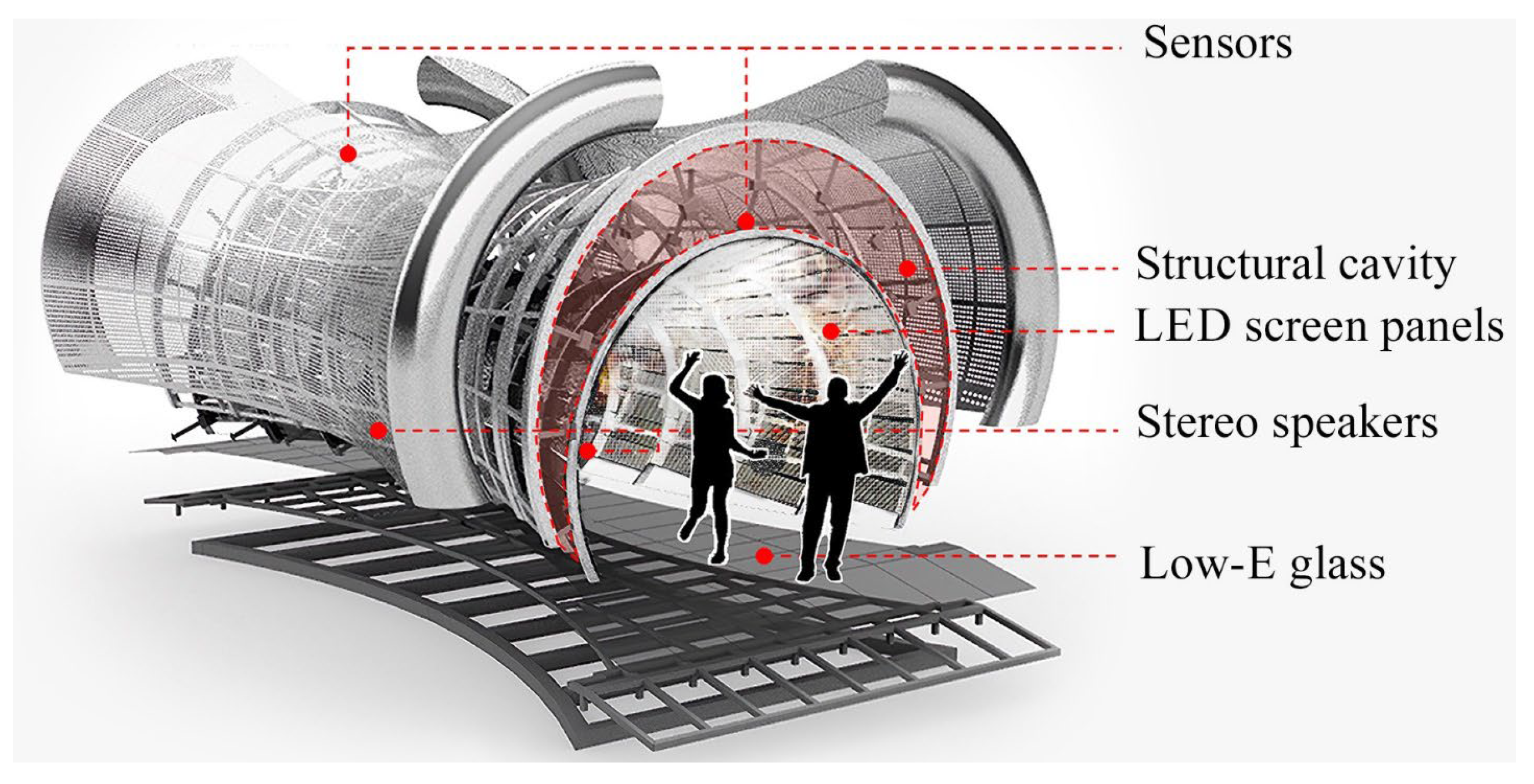
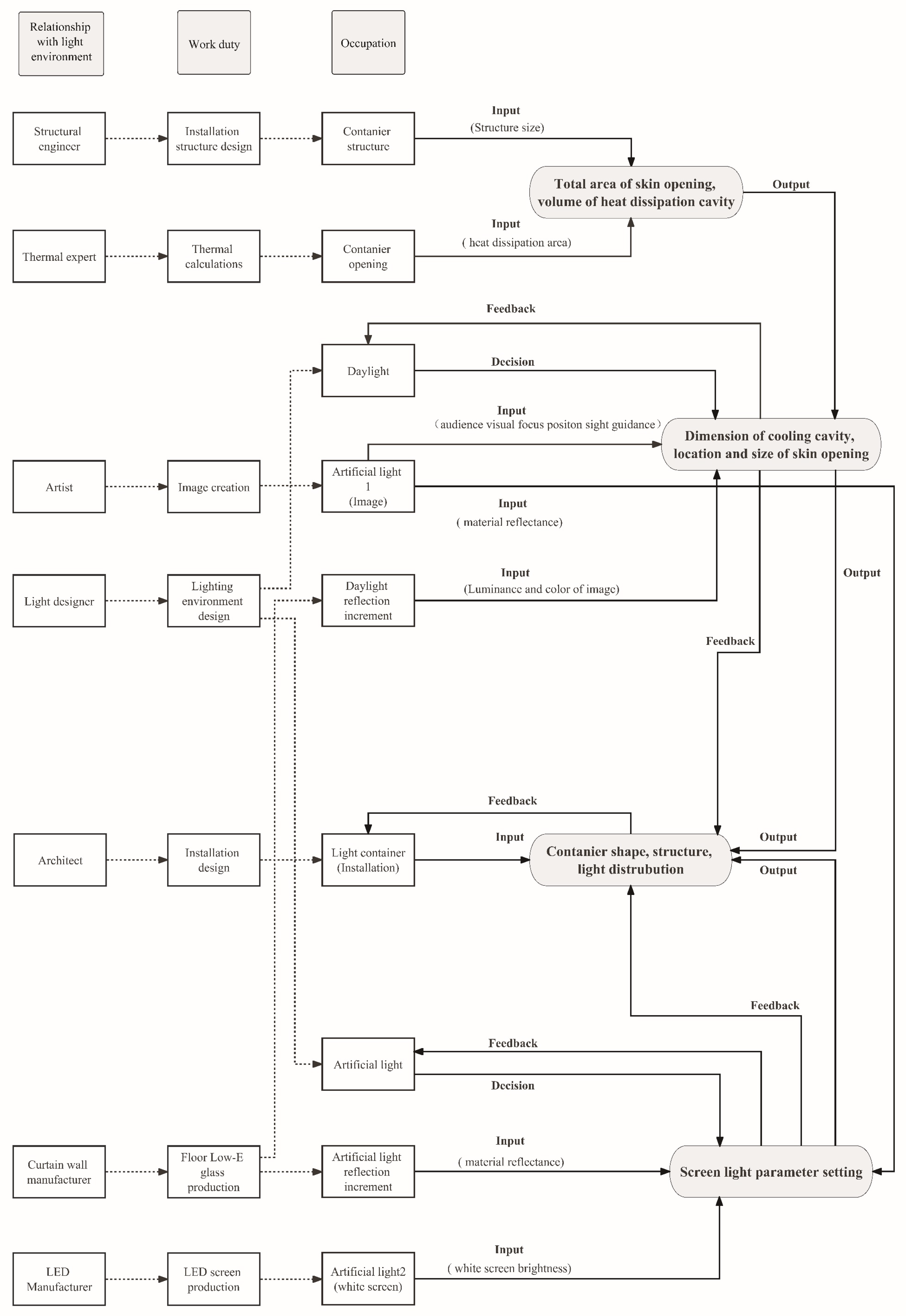

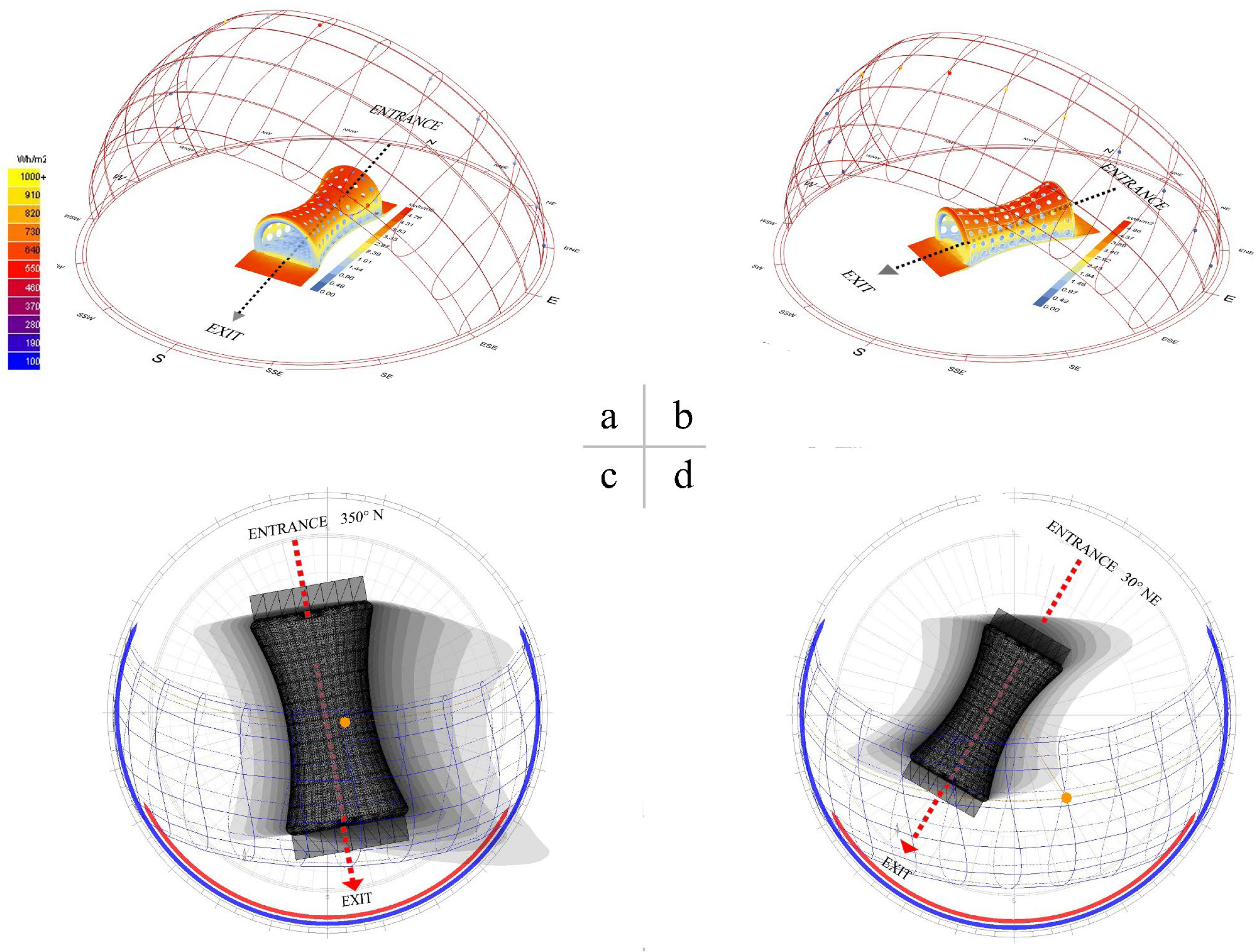
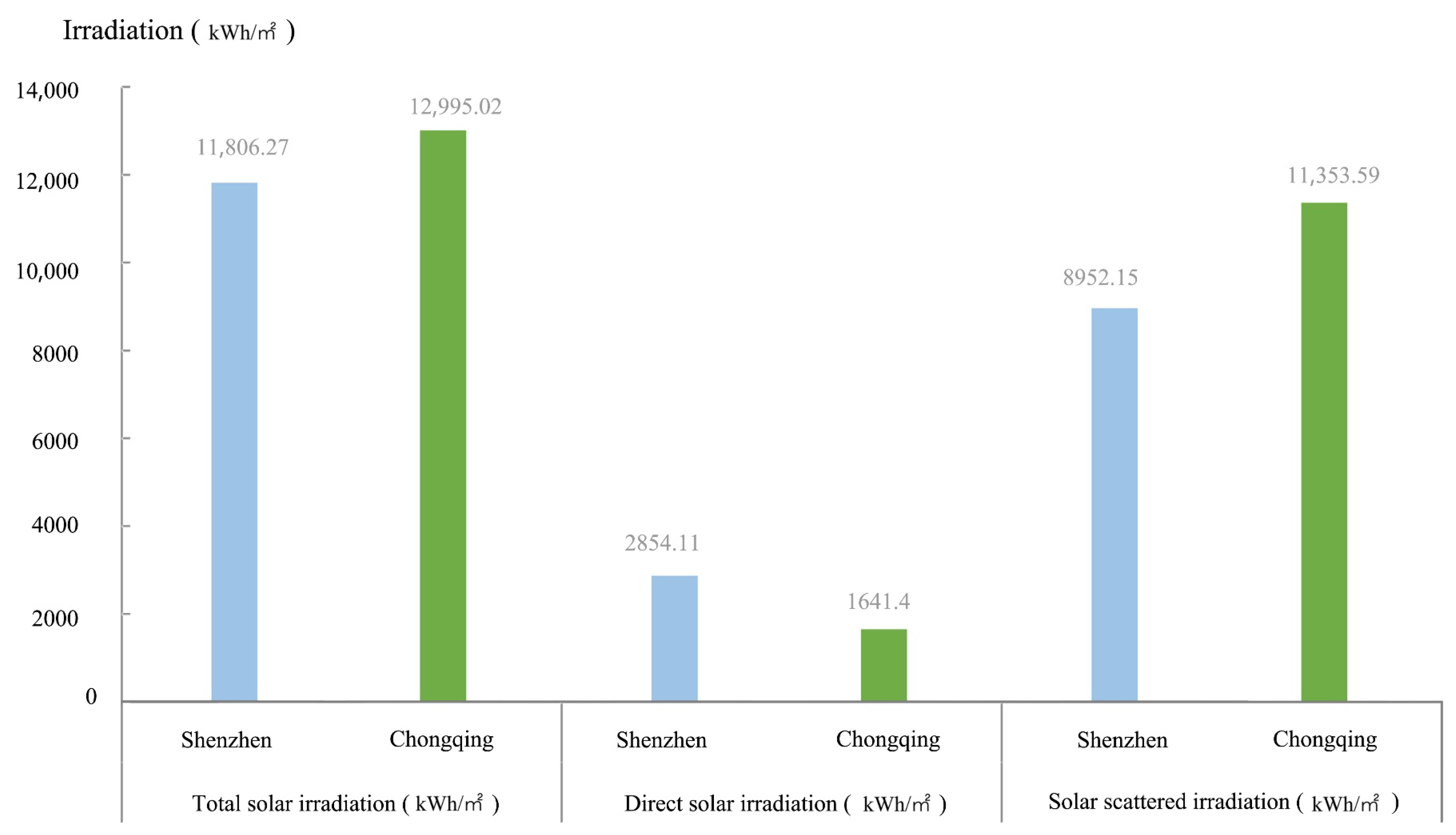



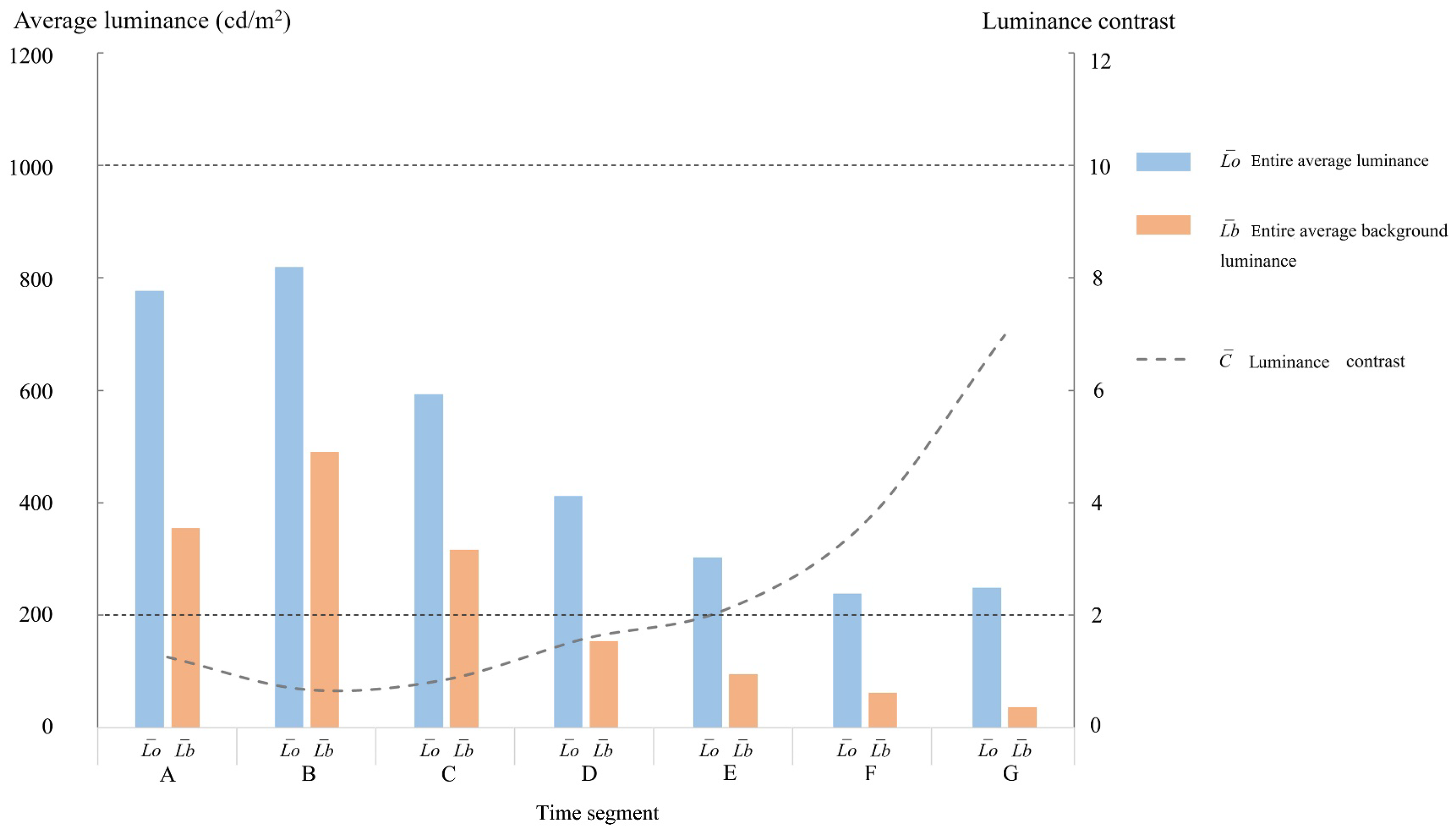

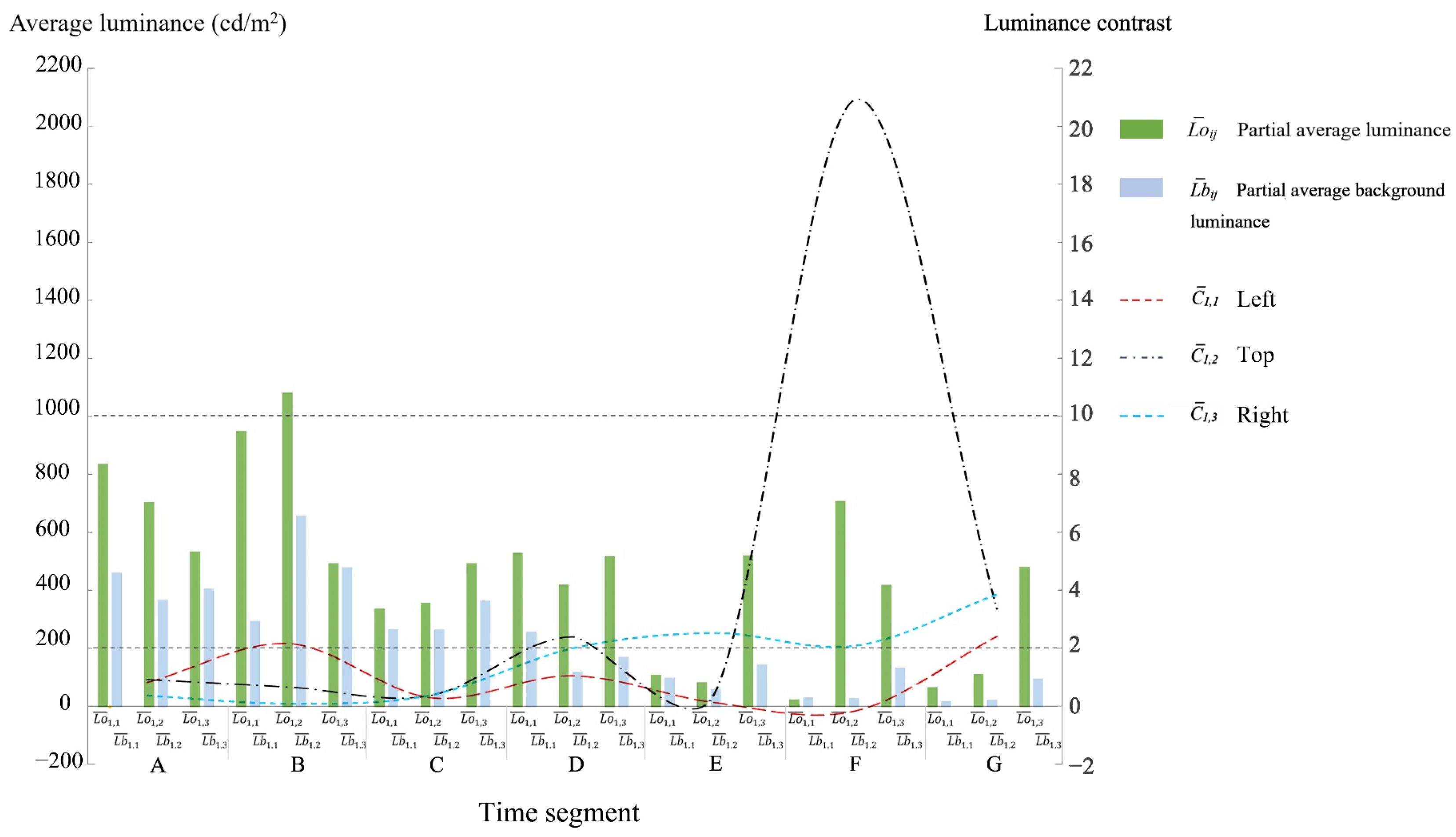
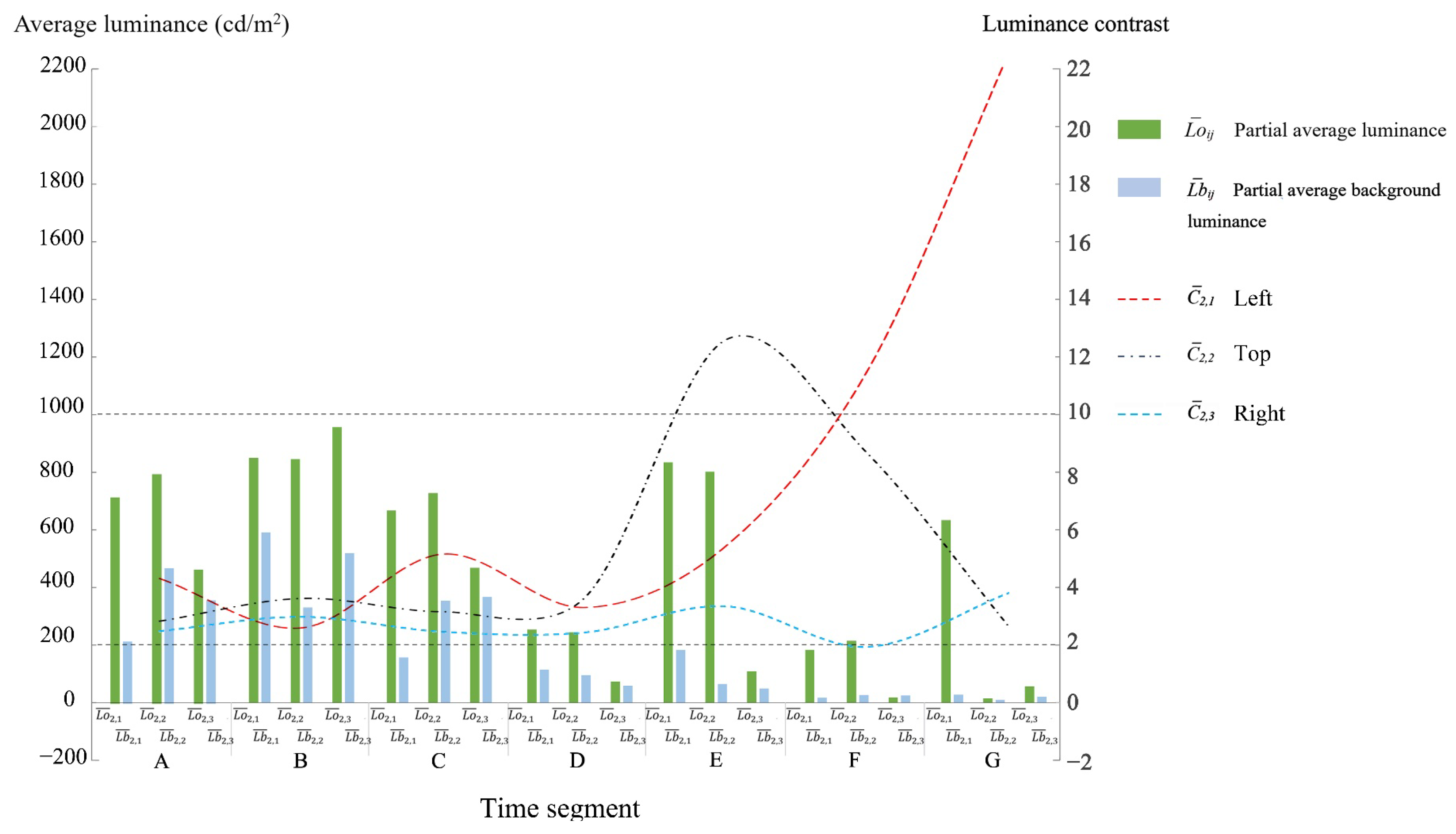
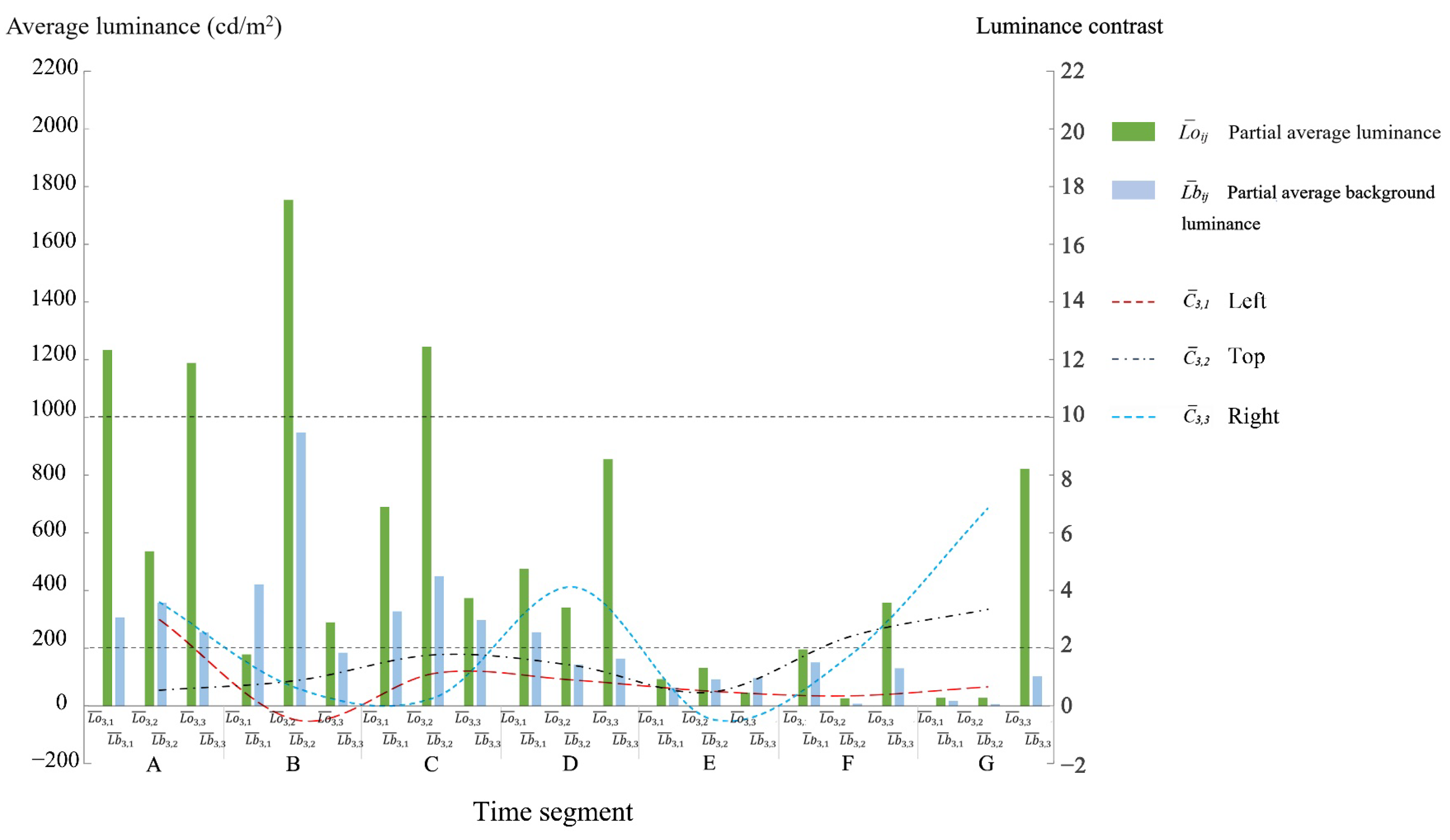
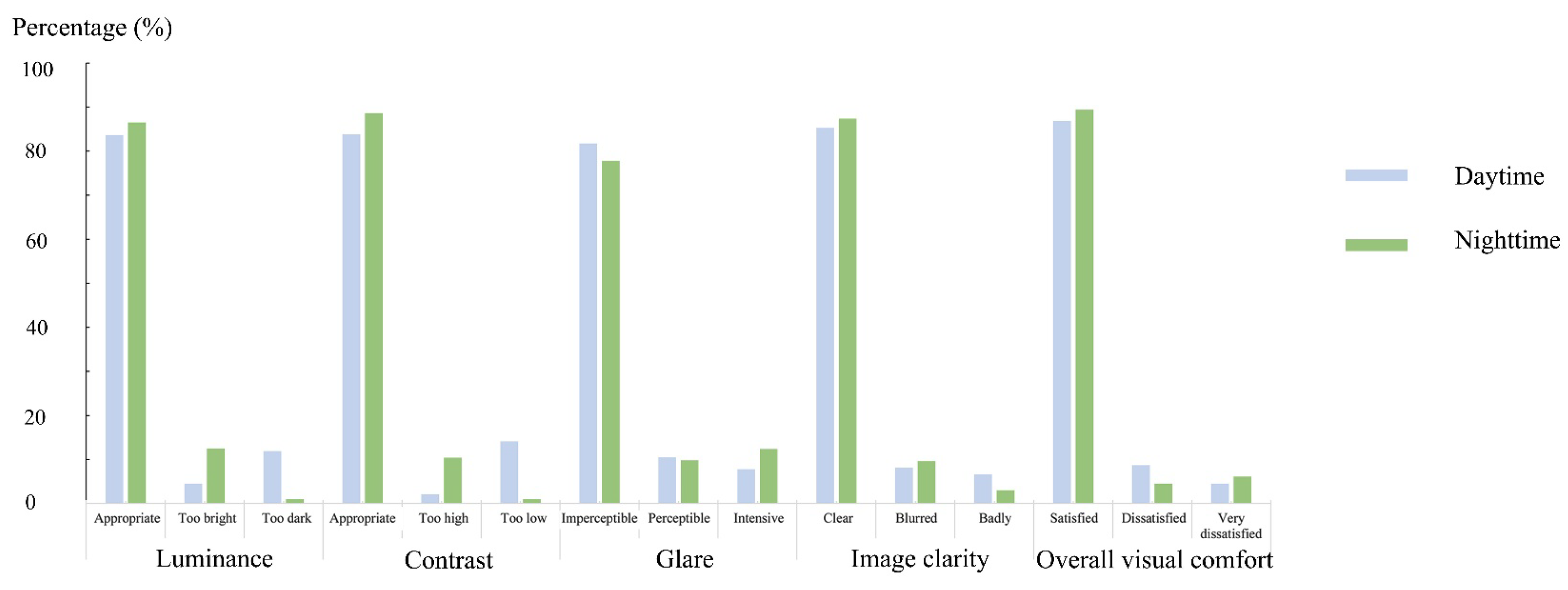
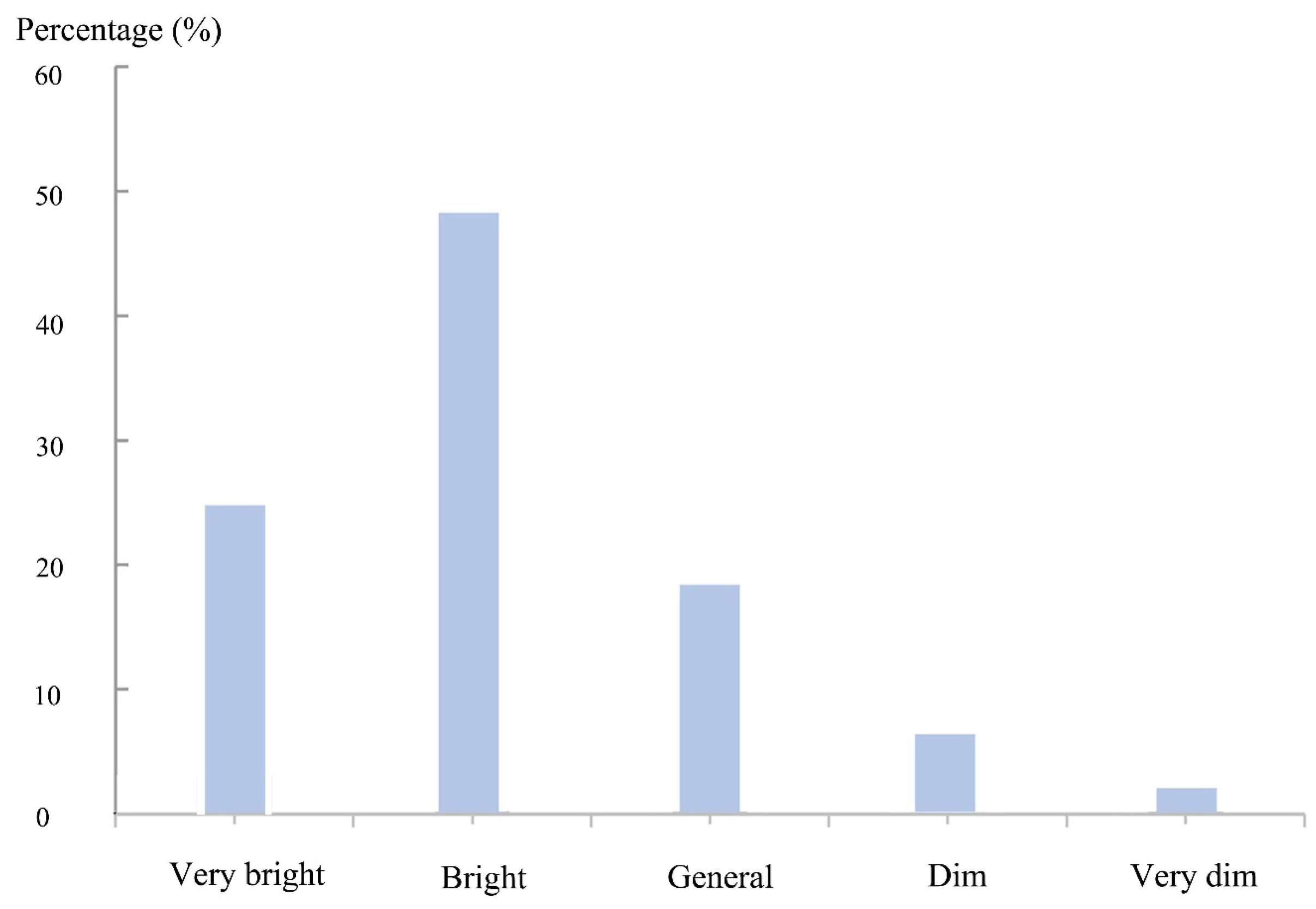
| No. | Standards and Guidelines/ Corresponding Terms | Application Conditions | Environmental Zones/ Sign or LED Display Screen Luminance (cd/m2) | Note | ||||
|---|---|---|---|---|---|---|---|---|
| 1 | CIE 234:2019 A Guide to Urban Lighting Masterplanning [46]. 6.4.5 Table 6 | Sign average luminance | — | E1 | E2 | E3 | E4 | CIE 234:2019 [46] 6.3 Table 4: E1—Intrinsically dark; large parklands and natural spaces E2—Low district brightness; center of large squares, small parks, some residential areas E3—Medium district brightness; some residential and small business areas E4—High district brightness; city centers and other busy commercial areas |
| — | 50 | 400 | 800 | 1000 | ||||
| 2 | GB/T 36101-2018 Evaluation requirements for obtrusive light of LED panels [47]. 5.3 Table 2 | Full-color or multi-color display screen | — | E1 | E2 | E3 | E4 | E1–No lighting areas; forest parks, observatory surroundings, nature reserves E2—Low district brightness; residential areas, hospitals, etc. E3—General public areas E4—City centers; business districts |
| — | 50 | 200 | 400 | 600 | ||||
| 3 | CIE 150:2017 Guide on the Limitation of the Effects of Obtrusive Light from Outdoor Lighting Installation [48]. 3.6.5.5 Table 7 | Sign luminance | E0 | E1 | E2 | E3 | E4 | E0—Intrinsically dark; UNESCO Starlight Reserves, IDA Dark sky parks; major optical observatories E1—Dark; relatively uninhabited rural areas E2—Low district brightness; sparsely inhabited rural areas E3—Medium district brightness; well-inhabited rural and urban settlements E4—High district brightness; town and city centers and other commercial areas |
| <0.1 | 50 | 400 | 800 | 1000 | ||||
| 4 | GB/T 35626-2017 Specification for limitation to obtrusive light of outdoor lighting [25]. 5.7.2 Table 8 | Full-color LED display or media wall surface | — | E1 | E2 | E3 | E4 | E1—Intrinsically dark; national parks, nature reserves E2—Low district brightness; suburban residential areas E3—Medium district brightness; urban residential areas, general public areas E4—High district brightness; town and city centers, business districts |
| — | — | 200 | 400 | 600 | ||||
| 5 | JGJ/T 163-2008 Code for lighting design of urban nightscape [26]. 5.6 Table 5.6.2 | Advertising and Sign lighting areas, S > 10 m2 | — | E1 | E2 | E3 | E4 | E1—Intrinsically dark; national parks, nature reserves, observatory surroundings, etc. E2—Low district brightness; industrial or residential places in rural areas, etc. E3—Medium district brightness; well-inhabited rural and urban settlements E4—High district brightness; town and city centers and other commercial areas |
| — | — | 150 | 300 | 400 | ||||
Disclaimer/Publisher’s Note: The statements, opinions and data contained in all publications are solely those of the individual author(s) and contributor(s) and not of MDPI and/or the editor(s). MDPI and/or the editor(s) disclaim responsibility for any injury to people or property resulting from any ideas, methods, instructions or products referred to in the content. |
© 2023 by the authors. Licensee MDPI, Basel, Switzerland. This article is an open access article distributed under the terms and conditions of the Creative Commons Attribution (CC BY) license (https://creativecommons.org/licenses/by/4.0/).
Share and Cite
Yan, Y.; Zhong, Y.; Zhang, B.; Weng, Z.; Niu, S.; Zeng, Y.; Cheng, X.; Zhong, B. Light Environment Evaluation of the Architecturalized Immersive New Media Public Art Installation from the Audiences’ Visual Safety Perspective. Buildings 2023, 13, 2122. https://doi.org/10.3390/buildings13082122
Yan Y, Zhong Y, Zhang B, Weng Z, Niu S, Zeng Y, Cheng X, Zhong B. Light Environment Evaluation of the Architecturalized Immersive New Media Public Art Installation from the Audiences’ Visual Safety Perspective. Buildings. 2023; 13(8):2122. https://doi.org/10.3390/buildings13082122
Chicago/Turabian StyleYan, Yonghong, Yi Zhong, Bohan Zhang, Ziming Weng, Shuhui Niu, Yue Zeng, Xiang Cheng, and Biao Zhong. 2023. "Light Environment Evaluation of the Architecturalized Immersive New Media Public Art Installation from the Audiences’ Visual Safety Perspective" Buildings 13, no. 8: 2122. https://doi.org/10.3390/buildings13082122
APA StyleYan, Y., Zhong, Y., Zhang, B., Weng, Z., Niu, S., Zeng, Y., Cheng, X., & Zhong, B. (2023). Light Environment Evaluation of the Architecturalized Immersive New Media Public Art Installation from the Audiences’ Visual Safety Perspective. Buildings, 13(8), 2122. https://doi.org/10.3390/buildings13082122










